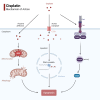The role of cisplatin in modulating the tumor immune microenvironment and its combination therapy strategies: a new approach to enhance anti-tumor efficacy
- PMID: 39757995
- PMCID: PMC11705547
- DOI: 10.1080/07853890.2024.2447403
The role of cisplatin in modulating the tumor immune microenvironment and its combination therapy strategies: a new approach to enhance anti-tumor efficacy
Abstract
Cisplatin is a platinum-based drug that is frequently used to treat multiple tumors. The anti-tumor effect of cisplatin is closely related to the tumor immune microenvironment (TIME), which includes several immune cell types, such as the tumor-associated macrophages (TAMs), cytotoxic T-lymphocytes (CTLs), dendritic cells (DCs), myeloid-derived suppressor cells (MDSCs), regulatory T cells (Tregs), and natural killer (NK) cells. The interaction between these immune cells can promote tumor survival and chemoresistance, and decrease the efficacy of cisplatin monotherapy. Therefore, various combination treatment strategies have been devised to enhance patient responsiveness to cisplatin therapy. Cisplatin can augment anti-tumor immune responses in combination with immune checkpoint blockers (such as PD-1/PD-L1 or CTLA4 inhibitors), lipid metabolism disruptors (like FASN inhibitors and SCD inhibitors) and nanoparticles (NPs), resulting in better outcomes. Exploring the interaction between cisplatin and the TIME will help identify potential therapeutic targets for improving the treatment outcomes in cancer patients.
Keywords: Cisplatin; combination therapy; immune therapy; lipid metabolism disruptors; tumor immune microenvironment.
Conflict of interest statement
No potential conflict of interest was reported by the author(s).
Figures




Similar articles
-
CD40-mediated immune cell activation enhances response to anti-PD-1 in murine intrahepatic cholangiocarcinoma.J Hepatol. 2021 May;74(5):1145-1154. doi: 10.1016/j.jhep.2020.11.037. Epub 2020 Dec 1. J Hepatol. 2021. PMID: 33276030 Free PMC article.
-
PI3Kγδ inhibitor plus radiation enhances the antitumour immune effect of PD-1 blockade in syngenic murine breast cancer and humanised patient-derived xenograft model.Eur J Cancer. 2021 Nov;157:450-463. doi: 10.1016/j.ejca.2021.08.029. Epub 2021 Oct 1. Eur J Cancer. 2021. PMID: 34601286
-
Alum-anchored IL-12 combined with cytotoxic chemotherapy and immune checkpoint blockade enhanced antitumor immune responses in head and neck cancer models.J Immunother Cancer. 2024 Oct 23;12(10):e009712. doi: 10.1136/jitc-2024-009712. J Immunother Cancer. 2024. PMID: 39448201 Free PMC article.
-
Dendritic Cells, the T-cell-inflamed Tumor Microenvironment, and Immunotherapy Treatment Response.Clin Cancer Res. 2020 Aug 1;26(15):3901-3907. doi: 10.1158/1078-0432.CCR-19-1321. Epub 2020 Apr 24. Clin Cancer Res. 2020. PMID: 32332013 Free PMC article. Review.
-
A Combination of Immune Checkpoint Inhibition with Metronomic Chemotherapy as a Way of Targeting Therapy-Resistant Cancer Cells.Int J Mol Sci. 2017 Oct 13;18(10):2134. doi: 10.3390/ijms18102134. Int J Mol Sci. 2017. PMID: 29027915 Free PMC article. Review.
Cited by
-
Recent Advances in the Mechanisms and Applications of Astragalus Polysaccharides in Liver Cancer Treatment: An Overview.Molecules. 2025 Jun 28;30(13):2792. doi: 10.3390/molecules30132792. Molecules. 2025. PMID: 40649307 Free PMC article. Review.
References
Publication types
MeSH terms
Substances
LinkOut - more resources
Full Text Sources
Medical
Research Materials
Miscellaneous
